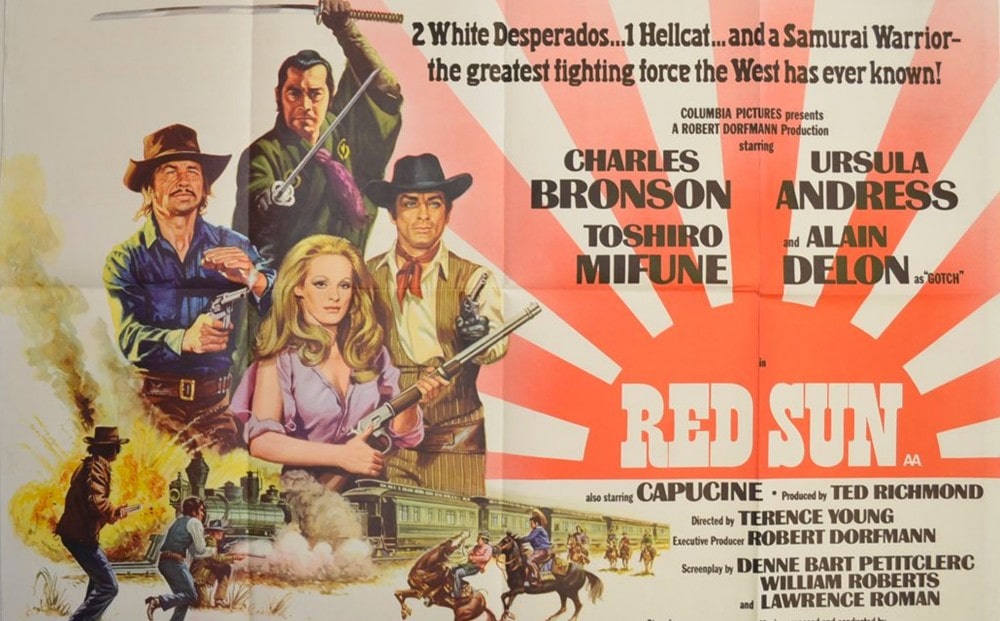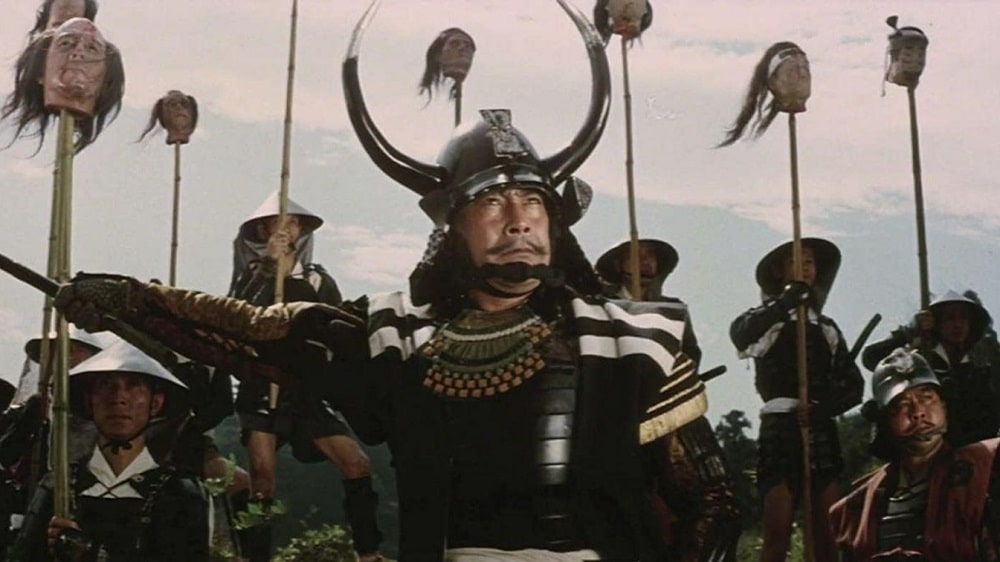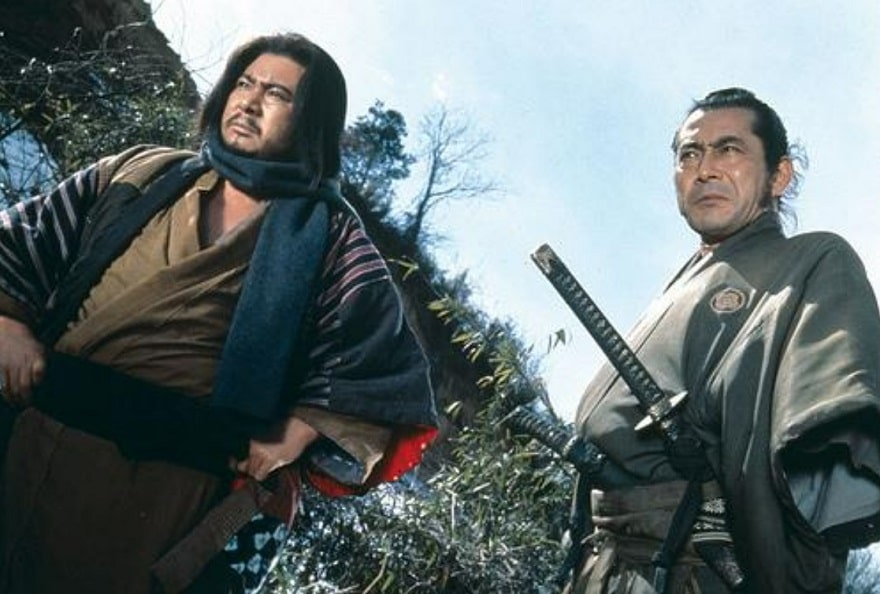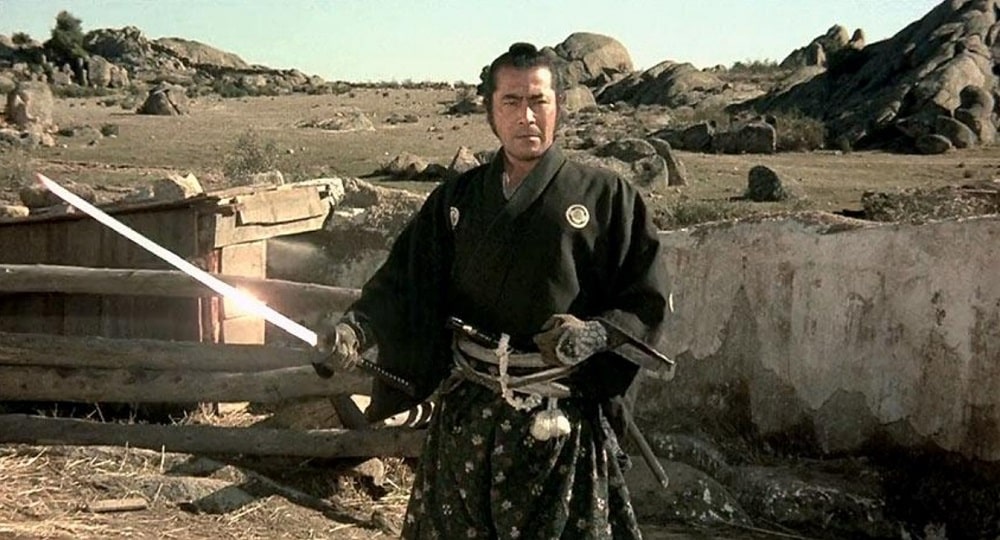Ellsworth’s Cinema of Swords: Moar Mondo Mifune
Red Sun (France/Italy/Spain, 1971)
Though Toshiro Mifune in the late ‘50s and early ‘60s had proven himself a consummate actor capable of inhabiting a wide range of roles, by the late ‘60s he was pretty much typecast as a gruffly stoic warrior oozing with gravitas. That sounds limiting, and though Mifune plays that part in each of the films covered this week, the three movies are so varied they prove Mifune’s breadth as a performer even when seemingly typecast. Plus, the latter two of these movies are just a rollicking good time, and if you haven’t heard of them, I’m delighted to bring them to your attention.
Samurai Banners
Rating: ***
Origin: Japan, 1969
Director: Hiroshi Inagaki
Source: Samurai Cinema DVD
Produced by and starring Toshiro Mifune, Samurai Banners was directed by Hiroshi Inagaki, with whom Mifune made more films than for any other director. It’s Inagaki’s penultimate feature, and follows his penchant for filming the stories of Japan’s national epics: he’d tackled the story of Musashi Miyamoto in the Samurai trilogy (1954-1956), the Forty-Seven Ronin in Chushingura (1962), and here the rise of Takeda Shingen, renowned daimyo of the Warring States period, as told through the story of his leading general and strategist, Kansuke Yamamoto (1501-1561, by Western reckoning).
Kansuke (Mifune) came from obscure origins but was already an experienced warrior who had lost his lord and master, and thus went looking for a new position as a retainer for the promising young warlord Takeda (Nakamura Kinnosuke). In the first scene Kansuke shows both his talent for strategy and his ruthlessness by persuading another ronin to ambush one of Takeda’s traveling officers. Kansuke then intervenes, killing the other ronin, and the officer takes him into Takeda’s service.
Kansuke proves his worth to his new lord when he advises Takeda to assassinate a rival daimyo of the Suwa clan, a bold move that Takeda was already considering but which didn’t occur to his more conventional advisors. Kansuke then advises Takeda to take Suwa’s daughter, Princess Yu (Yoshiko Sakuma), as his concubine to bind the Suwa to him, and in hopes that Yu will bear Takeda a son and heir — which she does, but not before falling into a love/hate relationship with both Kansuke and Takeda. It’s extra poignant.
As you’ve probably picked up, this isn’t a chambara swordplay adventure, it’s a doomed romance wrapped in a historical military epic, and soon the armies are on the march, in all the panoply of 16th-century Japanese warfare. The battle scenes are bloody gorgeous, and if Inagaki has trouble making it clear what’s going on when all these thousands of fabulously armed and armored soldiers wheel, charge, and clash, well, not everybody is an Eisenstein or Kurosawa. What we chiefly care about is Mifune as Kansuke, a stoic veteran with a caterpillar-like scar over one eye and a pronounced limp that has him leaning on a cane. However, in the saddle the years melt away and he’s young again, wearing amazing armor with great curving horns sprouting from his helm as he directs the mayhem of battle with stentorian commands and flashing katana.
Eventually Takeda’s victories bring him up against another talented warlord, Uesugi Kenshin, and Kansuke directs Takeda’s strategy in a ten-year duel with Takeda’s great rival. It all culminates in the Fourth Battle of Kawanakajima, in which Kansuke makes his first — and last — strategic mistake.
So, watch it or not? The samurai politics aren’t very compelling if you’re not already well versed in this stuff, but the doomed romance almost works, and the battles make for fine spectacles. Mifune’s performance tips the balance: he’s in excellent form here, caterpillar scar and all, and his Kansuke Yamamoto is a standout, even in a career of remarkable roles. Verdict: watch it.
Ambush at Blood Pass (or Incident at Blood Pass or Machibuse)
Rating: *****
Origin: Japan, 1970
Director: Hiroshi Inagaki
Source: Warrior DVD
Who doesn’t love a movie in which seven strangers, each with their own secret agenda, come together in a lonely inn in a snowy mountain pass with murder in the icy air?
Toshiro Mifune dons the gray kimono and gruff mannerisms of the nameless ronin from Yojimbo and Sanjuro again for the second time in a year (see Zatoichi Meets Yojimbo), once more co-starring with Shintaro Katsu. This time the itinerant samurai is offered a mysterious job from a hooded man in the shadows known only as “Crow,” who tells him to go to Shansu Pass and “Wait until something happens — you’ll know what to do.”
Intrigued, the laconic yojimbo (bodyguard) does just that. On the way up the mountain he liberates a woman named Okuni (Ruriko Asaoka) from an abusive husband, and she follows him to the Minoya Inn. This remote teahouse, run by an elderly man and his granddaughter, is already housing Gentetsu (Katsu), a man on the run who claims to be an ex-doctor from Edo. They’re soon joined by Yatarou (Yujiro Ishihara), a handsome but shady gambler, and a wounded police officer, Ibuki (Kinnosuke Nakamura), with a captive crook, Tatsu the Wild Monkey (Ryonosuke Yamazaki). As the others begin quarreling, the wandering yojimbo… waits for something to happen.
And things do begin to happen, slowly at first, and then all in a rush. Gentetsu makes a pass at Okuni, but she rebuffs him. Then two riders arrive, claiming to be police, enticing officer Ibuki to bring Tatsu along and leave with them, but the gambler and the yojimbo smell a rat and butt in. In a quick scuffle, the yojimbo kills one rider but the other gets away. The dead man’s tattoos prove him a gangster, but no one can explain why two gangsters would try to rescue a cheap crook like the Wild Monkey.
The yojimbo goes out to scout the pass, and in the meantime Okuni’s brutal husband arrives. He tries to get Okuni to leave with him, and when she refuses, he gets aggressive — but suddenly the inn is invaded by an entire criminal gang and everything changes. The gang takes over the inn and Gentetsu comes forward and reveals himself as their leader. When the gruff yojimbo returns, he assesses the situation, and when he’s challenged, he just tells Gentetsu that they work for the same employer and he was sent to help him — and he shows Crow’s letter to prove it.
As usual, the yojimbo is just going along with the goons until he sees his opportunity. Gentetsu lets him in on their caper: they’re planning to rob a Shogunate gold shipment that will be coming through the pass. But it’s more than just a heist, there’s a political angle to the job as well. And that’s all the yojimbo needs to hear to realize that he’s caught in the middle of a classic double cross. Time to loosen his sword in its sheath.
This is the final feature film of the veteran director Hiroshi Inagaki, and he handles the story’s taut suspense and sudden violence with complete mastery. Mifune is wryly self-possessed, Katsu is menacing, Asaoka is brave under pressure, and the evil mastermind Crow gets what he deserves. In its own small way, this movie is kind of perfect.
Red Sun
Rating: ****
Origin: France/Italy/Spain, 1971
Director: Terence Young
Source: Evergreen Entertainment DVD
Given all the cross-fertilization between the chambara and Spaghetti Western genres, in hindsight it seems inevitable that someone would make a Spaghetti Western with samurai in it. This one stars Charles Bronson and Toshiro Mifune as the protagonists, with Alain Delon as the villain and Ursula Andress as the female lead.
1860, the American West: a steam locomotive chuffs across the wild country pulling passenger cars, a mail car with a shipment of government gold, a cavalry troop to protect it, and a diplomatic car transporting the first Japanese ambassador to the United States. Among the passengers are members of a bandit gang led by Link (Bronson) and Gauche (Delon) who stop the train; a diversionary attack gets the cavalry out of their car, and then the bandits drive off with the train and leave them behind. They steal $400,000 in gold, rob the passengers and then the ambassador, taking his money and a gold-hilted Japanese sword meant as a gift for the U.S. President. One of the two samurai guards is shot and killed by Gauche, and the other, Kuroda (Mifune), vows revenge.
Meanwhile, Gauche casually betrays Link, blowing him out of the train with dynamite, and rides off with the loot. But Link jumps when he sees the TNT coming and survives, only to be captured by Kuroda when he revives. The ambassador tasks Kuroda and Link with recovering the sword and gives them seven days to do it, or Kuroda will have to commit ritual suicide. “That’s something I’d like to see,” says Link, but Kuroda promises him he won’t be alive to see it.
And now comes the real fun, as the captive outlaw leads the samurai warrior, very much out of his element, in pursuit of Gauche, the gold, and the sword. The two are initially contemptuous of each other, and Link isn’t shy about showing it. Though unarmed, the gunfighter is confident he’ll be able to escape Kuroda, but he finds that he can’t outrun him, outfox him, or even outfight him when he challenges the samurai to put down his swords and battle it out on equal terms. (Jiu jitsu, y’all.)
By the time they catch up with some of Gauche’s gang and appropriate their guns and horses, Link has learned respect for the samurai and doesn’t shoot Kuroda out of hand — though he does insist that the samurai promise not to kill Gauche until Link has had enough time to force him to say where he’s hidden the bulk of the gold.
They lose Gauche’s trail, so Link decides to go to the small town of San Lucas because he’s sure Gauche will show up there to visit his lover, a prostitute named Cristina (Andress). But Gauche doesn’t come personally, instead sending some of his toughest men to pick up Cristina, and in the ensuing fight in a brothel Link’s own skills earn Kuroda’s grudging respect. They take Cristina hostage and set off to lure Gauche out of his mountain lair, a plan complicated by crossing paths with a war band of Comanche renegades.
This is a fine action film, confidently overseen by the British director Terence Young, who’d helmed three of the first four Connery Bond movies. Despite being a pair of stone-faced grunters, Bronson and Mifune have real chemistry together and show some wry wit as their disdain changes to mutual regard. Delon is a stylish villain in his dapper gambler’s suit and black gloves, someone you can’t root for but have to admire. Despite being second-billed behind Bronson, Andress isn’t given much to do, and her role is mostly ornamental. Bronson was at the height of his fame in Europe and Japan, and this film played for a record-setting 35 weeks at a first-run theater in Tokyo. Give it a squint.
Cinema of Swords will be published in June 2023 by Applause Books. Watch for it!
Where can I watch these movies? I’m glad you asked! Many movies and TV shows are available on disk in DVD or Blu-ray formats, but nowadays we live in a new world of streaming services, more every month it seems. However, it can be hard to find what content will stream in your location, since the market is evolving and global services are a patchwork quilt of rights and availability. I recommend JustWatch.com, a search engine that scans streaming services to find the title of your choice. Give it a try. And if you have a better alternative, let us know.
Previous installments in the Cinema of Swords include:
Swashbucklin’ Talkies
Barbarian Boom Part 6
Valiant Avenging Chivalry
Buccaneers Three
For the Horde!
The Princess Bride Redeems the 80s
Samurai Stocking Stuffers
Moonraker! (No, Not That One)
Cinema of Swords Book Announcement!
Fury of the Norsemen
Samurai With a Twist
The Barbarian Boom, Part 7
Avenging Women
LAWRENCE ELLSWORTH is deep in his current mega-project, editing and translating new, contemporary English editions of all the works in Alexandre Dumas’s Musketeers Cycle; the sixth volume, Court of Daggers, is available now as an ebook or trade paperback from Amazon, while the seventh, Devil’s Dance, is being published in weekly installments at musketeerscycle.substack.com. His website is Swashbucklingadventure.net. Check them out!
Ellsworth’s secret identity is game designer LAWRENCE SCHICK, who’s been designing role-playing games since the 1970s. He now lives in Dublin, Ireland, where he’s a Narrative Design Expert for Larian Studios, writing Dungeons & Dragons scenarios for Baldur’s Gate 3.




Toshiro Mifune AND Alain Delon in the same movie? Be still, my heart!
I was surprised by how emotive Charles Bronson is in Red Sun which is played off the stoic Mifune. Mifune can be extremely emotive (and get away with it without being melodramatic.) It is almost a reversal of their images.
Another Ellsworth’s Cinema of Swords? Mifune Yes!
I’ve seen both Red Sun and Ambush at Blood Pass (they’re great!) but I’m not familiar with Samurai Banners at all. Thanks for the tip!
I caught Red Sun by chance back in like 1986 on my little black and white TV. I was hooked instantly! Like, so hooked I had to tell my mom I was skipping dinner until this was over. I’ve stumbled across it a couple of times since and finally got it on DVD. A true classic!
“Gun. Sword. All men die same way.”